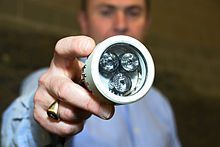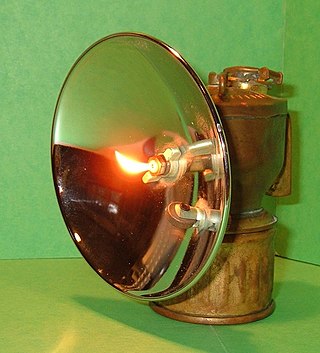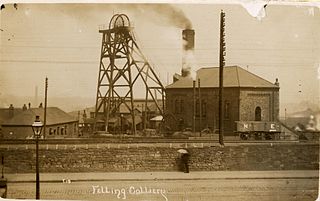
A mining lamp is a lamp, developed for the rigid necessities of underground mining operations. Most often it is worn on a hard hat in the form of a headlamp.

A mining lamp is a lamp, developed for the rigid necessities of underground mining operations. Most often it is worn on a hard hat in the form of a headlamp.
Types
1813 Dr William Reid Clanny Exhibited The Clanny Lamp
1815 Humphry Davy Exhibited The Davy Lamp
1815 George Stephenson Exhibited his Lamp
The Davey Safety Lamp was made in London by Humphry Davy. George Stephenson invented a similar lamp but Davys invention was safer due to it having a fine wire gauze that surrounded the flame. This enabled the light to pass through and reduced the risk of explosion by stopping the "firedamp" methane gas coming in contact with the flame. [1]
1840 Mathieu Mueseler Exhibited The Museler Lamp in Belgium. [2]
1859 William Clark patented the first electrical mining lamp. [3]
1870s J.B.Marsaut (France) double gauze design [4]
1872 Coal Mines Regulation Act required locked lamps under certain conditions [5]
1881 Joseph Swan exhibited his first electric lamp
1882 Made by William Reid Clanny invented a 'bonnetted' Clanny lamp, [6]
1883 Elliis Lever of Culcheth Hall Bowdon offered a £500 prize for creation of a safe portable mining lamp. [7] [8]
1885 Thomas Evans of Aberdare made a Clanny type of safety lamp [9]
1886 Royal Commission on Accidents in Mines tested lamps and made recommendations
1887 Coal Mines Regulation Act – requirements on construction, examination, where used, etc. [10]
1889 John Davis and Co, Derby, were supplying portable electric lamps [11]
1896 Coal Mines Regulation Act - requirements on provision by mine owners, where to be used, etc. [12]
1909 Cap (helmet) lamps introduced in Scotland
1911 Prize offered for best electrical lamp
1911 Coal Mines Act made requirements for pit managers to take examinations, where can be used (including electrical), etc.
1920 Electrical lamp with built in accumulator
1924 Miners Lamp Committee – tests and recommendations
1950 Shale miner's electric safety cap lamp and battery pack made in England and supplied by Concordia Electric Safety Lamp Company Ltd, Cardiff. [13]

The Davy lamp is a safety lamp used in flammable atmospheres, invented in 1815 by Sir Humphry Davy. It consists of a wick lamp with the flame enclosed inside a mesh screen. It was created for use in coal mines, to reduce the danger of explosions due to the presence of methane and other flammable gases, called firedamp or minedamp.
Firedamp is any flammable gas found in coal mines, typically coalbed methane. It is particularly found in areas where the coal is bituminous. The gas accumulates in pockets in the coal and adjacent strata and when they are penetrated the release can trigger explosions. Historically, if such a pocket was highly pressurized, it was termed a "bag of foulness".
The Blantyre mining disaster, which happened on the morning of 22 October 1877, in Blantyre, Scotland, was Scotland's worst ever mining accident. Pits No. 2 and No. 3 of William Dixon's Blantyre Colliery were the site of an explosion which killed 207 miners, possibly more, with the youngest being a boy of 11. It was known that firedamp was present in the pit and it is likely that this was ignited by a naked flame. The accident left 92 widows and 250 fatherless children.

The Mine Safety and Health Administration (MSHA) is a large agency of the United States Department of Labor which administers the provisions of the Federal Mine Safety and Health Act of 1977 to enforce compliance with mandatory safety and health standards as a means to eliminate fatal accidents, to reduce the frequency and severity of nonfatal accidents, to minimize health hazards, and to promote improved safety and health conditions in the nation's mines. MSHA carries out the mandates of the Mine Act at all mining and mineral processing operations in the United States, regardless of size, number of employees, commodity mined, or method of extraction. David Zatezalo was sworn in as Assistant Secretary of Labor for Mine Safety and Health, and head of MSHA, on November 30, 2017. He served until January 20, 2021. Jeannette Galanais served as Acting Assistant Secretary by President Joe Biden on February 1, 2021 until Christopher Williamson took office on April 11, 2022.

The Geordie lamp was a safety lamp for use in flammable atmospheres, invented by George Stephenson in 1815 as a miner's lamp to prevent explosions due to firedamp in coal mines.

A Carbide lamp or acetylene gas lamp is a simple lamp that produces and burns acetylene (C2H2), which is created by the reaction of calcium carbide (CaC2) with water (H2O).
A safety lamp is any of several types of lamp that provides illumination in places such as coal mines where the air may carry coal dust or a build-up of inflammable gases, which may explode if ignited, possibly by an electric spark. Until the development of effective electric lamps in the early 1900s, miners used flame lamps to provide illumination. Open flame lamps could ignite flammable gases which collected in mines, causing explosions; safety lamps were developed to enclose the flame to prevent it from igniting the explosive gases. Flame safety lamps have been replaced for lighting in mining with sealed explosion-proof electric lights, but continue to be used to detect gases.
William Reid Clanny FRSE was an Irish physician and inventor of a safety lamp.

The Felling Colliery in Britain, suffered four disasters in the 19th century, in 1812, 1813, 1821 and 1847. By far the worst of the four was the 1812 disaster which claimed 92 lives on 25 May 1812. The loss of life in the 1812 disaster was one of the motivators for the development of miners' safety lamps such as the Geordie lamp and the Davy lamp.
Clifton Hall Colliery was one of two coal mines in Clifton on the Manchester Coalfield, historically in Lancashire which was incorporated into the City of Salford in Greater Manchester, England in 1974. Clifton Hall was notorious for an explosion in 1885 which killed around 178 men and boys.
Matthias Dunn was a British mining engineer and one of the first government inspectors of mines. He was known for encouraging safe practices in mines.

A headlamp, headlight, or head torch (UK) is a light source affixed to the head typically for outdoor activities at night or in dark conditions such as caving, orienteering, hiking, skiing, backpacking, camping, mountaineering or mountain biking. Headlamps may also be used in adventure races. Headlamps are often used by workers in underground mining, search and rescue, surgeons, and by other workers who need hands-free directed lighting.

The following outline is provided as an overview of and topical guide to mining:
The West Stanley Pit disasters refers to two explosions at the West Stanley colliery. West Stanley colliery was a coal mine near Stanley, with the mine opening in 1832 and closing in 1936. Over the years several seams were worked through four shafts: Kettledrum pit, Lamp pit, Mary pit and New pit. In 1882 an underground explosion killed 13 men and in 1909 another explosion killed 168 men.

The Bedford Colliery disaster occurred on Friday 13 August 1886 when an explosion of firedamp caused the death of 38 miners at Bedford No.2 Pit, at Bedford, Leigh in what then was Lancashire. The colliery, sunk in 1884 and known to be a "fiery pit", was owned by John Speakman.

A mine, i.e. an industrial facility for the underground extraction of mineral commodities, has three operating phases: it may be open or running, or closed or it may be a working museum. Most mines are simply closed once they are no longer productive. For safety they are usually partially destroyed. However, many mines are at least partially accessible today to visitors.
The Royce J. and Caroline B. Watts Museum is located in the Mineral Resources Building on the Evansdale campus of West Virginia University in Morgantown, West Virginia, and is “dedicated to preserving and promoting the social, cultural, and technological history of West Virginia’s coal and petroleum industries through the collection, preservation, research, and exhibition of historical objects and archival materials.” Originally named the COMER Museum for WVU's College of Mineral and Energy Resources, the Watts Museum was renamed in 2005 at the request of the West Virginia Coal Mining Institute (WVCMI).
This is a partial glossary of coal mining terminology commonly used in the coalfields of the United Kingdom. Some words were in use throughout the coalfields, some are historic and some are local to the different British coalfields.

Helen Monica Maurice was an industrialist and Managing Director and Chairman of the Wolf Safety Lamp Company, Sheffield, and the first, and for 40 years the only, woman member of the Association of Mining Electrical Engineers. She was known as “the Lady of the Lamp” in the coal fields of Yorkshire.
Evan Thomas was a Welsh ironmonger who became an inventor and manufacturer of safety lamps for miners. He was the original proprietor of the Cambrian Lamp Works, established in Aberdare in 1860.